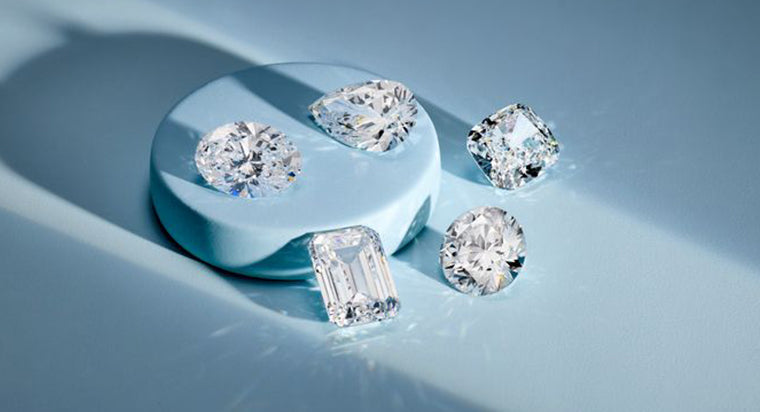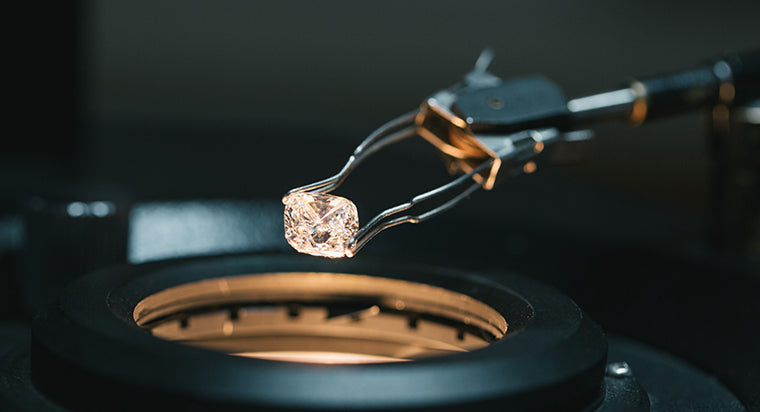Buying Natural vs. Synthetic Diamonds

There are many diamond alternatives that have come to market in recent years, and in some cases people could refer to these as “fake,” “synthetic,” or “simulated.” According to the Gemological Institute of America or GIA, lab made diamonds are also sometimes referred to as “man-made or synthetic diamonds.”
Whereas simulated diamonds are stones that only look like diamonds, like cubic zirconia, white sapphire, moissanite, zircon, rutile, spinel, and synthetic garnet.
TABLE OF CONTENTS
Are Lab Diamonds the same as Synthetic Diamonds?
Lab diamonds are not synthetic diamonds. Lab grown diamonds look identical to a natural diamond. They have the same properties as natural diamonds, the only difference is that they are grown in a lab, whereas natural diamonds are formed in the earth. Synthetic diamonds are alternatives to natural and lab grown diamonds. Common ones can include spinel, and cubic zirconia.
What is a natural diamond?
A natural diamond is made from carbon and is the hardest natural known substance on earth. Natural diamonds are created over a period of one to three billion years, at least 85 miles below the earth’s mantle under natural conditions of very high pressure and high temperature. Once a diamond has been created in these underground conditions, it travels via molten rock to the earth’s surface, where it is mined, refined, and turned into beautiful jewelry or used for industrial purposes. Learn more about how diamonds are formed.
What is a lab diamond?
A lab or man-made diamond is made under very similar conditions of very high pressure and high temperature. First a diamond seed is selected to undergo extreme conditions in a lab environment. After a few weeks, the diamond seed would have crystallized to a full rough diamond. Once done, it is then cut and polished. The end result is a diamond with the same chemical and optical properties of a natural diamond.
Lab versus Simulated Diamonds
Simulated diamonds are not true natural diamonds as they have either been manufactured or chemically altered. Simulated diamonds can include cubic zirconia, white sapphire, moissanite, zircon, rutile, spinel, and synthetic garnet.
Whereas lab grown diamonds are created with the same physical and chemical properties as a natural diamond would have. However, they are created by man and are not made in nature.
Despite simulated diamonds being chemically unlike natural diamonds, and lab diamonds not occuring in nature, the positive is, lab and simulated diamonds are much less expensive and do have diamond optical properties.
Benefits of Buying Natural and Lab Diamonds
Benefits of Natural Diamonds
There are a number of benefits to buying a natural diamond for an engagement ring, mainly being:
- A natural diamond’s value will usually increase over time with inflation. The larger a diamond the more rare it is, and this usually results in a good investment. The same applies for finding a diamond with perfect clarity and color.
- Natural diamonds have been purchased and traded for many more years than lab diamonds, making their pricing more stable over time.
- Moreover, natural diamonds that may appreciate more quickly in value include fancy colors such as canary yellow diamonds which are considered investment grade. If looking to make a great investment in a diamond the rarest natural diamonds are red. Pink and blue are also considered higher value in terms of appreciation.
Benefits of Lab Diamonds
What are lab grown diamonds? They are man-made diamonds, made using advanced technological processes in controlled lab environments. There are benefits to buying a lab grown diamond, many of which are:
- Lab conditions resemble those of natural diamonds that take millions of years to form within the earth. Therefore, the result is the same chemical and optical properties as a natural diamond.
- Because of the alternative offered by scientists in man-made diamonds, there is a shorter supply chain in terms of the diamond coming into the consumer’s hands. This reduces the cost for the end consumer. Therefore, lab grown diamonds provide a cost-effective alternative to the natural counterpart.
- Lab technicians are constantly monitoring temperature and pressure for lab diamond seeds to grow. Therefore, these types of stones would never take hundreds of years to grow. This enables lab diamond shoppers to have ample options to choose from.
- Lab grown means less impact on the environment, which means the diamond passes through fewer hands. A shorter supply chain could guarantee more transparency about the creation of your diamond.
Durability & Certification
A natural diamond may be more durable over time than other stones. Because they rate a 10 on the Mohs Scale of Hardness, they are an ideal choice for everyday wear. Since an engagement ring will be worn every day, in most cases, a natural diamond is the most obvious choice. However, lab diamonds are also a great choice because they rate 9.25 on the Mohs Scale of Hardness. Natural and lab diamonds are the most durable stones a woman could wear on her finger.
GIA Certification
GIA (Gemological Institute of America) was established in 1931 and is considered to be the world’s authority on certified diamonds. GIA is a non-profit institute that ensures that every report on a diamond is accurate and discloses its origin (natural or not), treatments that may have been performed on the stone, and grades the diamond for the 4 Cs – cut, clarity, color, and carat.
GIA is the foremost authority in the diamond industry worldwide and is considered unbiased. It can be difficult to find GIA certified diamonds less than 0.20 carat, but buying a GIA certified natural diamond engagement ring is one way to ensure that you know exactly what you’re buying. It can be very ambiguous how synthetics are categorized or described.
IGI Certification
The International Gemological Institute (IGI) was established back in 1975, and now has headquarters all over the globe. The independent laboratory carefully studies colored stones and jewelry, along with lab grown diamonds, to determine authenticity.
When shopping for the perfect diamond, most people only know what is appealing to the naked eye, and what is less so. What many jewelry consumers don’t realize is that a great deal of time and analysis went into the selection of diamonds from which they have to choose. Diamond specialists use a system called the IGI (International Gemological Institute) certification to accurately label and classify market-worthy diamonds. At With Clarity we give IGI certification to all lab/synthetic diamond purchases.
Which is better: GIA or IGI Diamond Certification?
While GIA and IGI certificates are both reputable and backed by leading laboratories, there is a more widespread use of GIA certificates within the natural diamond industry and among jewelers. However, both GIA and IGI grade on the same basic principles and diamond characteristics. Therefore, both can be trusted to provide honest assessments of diamonds.
Identifying Natural and Lab Diamonds
When it comes to identifying, man-made diamonds tend to have "tells” that may help you notice whether they are naturally occurring or not.
- First, an interesting test is thermal conductivity. Diamonds conduct and react to heat. Some lab diamonds do not.
- Second, their controlled lab creation can mean few or no clarity inclusions.
- In a lab, they are often made very colorless so they look very white, to capture light and optimize sparkle.
- Finally, the price is a tell all. If they are priced too well (up to 75% less than the price of a natural diamond), then you'll have a signal that the diamond may not be natural.
At With Clarity, we use natural diamonds, which are tested by GIA-trained graduate gemologists. We use equipment that is calibrated and measured to successfully differentiate between natural and nonnatural diamonds. Our diamonds come with GIA certificates as further verification of authenticity.
We also have the budget-friendly option of IGI certified lab diamonds, which are guaranteed conflict-free like our natural diamonds. Remember, lab grown diamonds have the same visual, physical, and chemical properties as a natural stone.
Whether choosing a natural, lab grown, or simulated diamond, it all comes down to personal preference. What’s important is having a diamond certified by a reputable gemologist, so that you know what you’re paying for.
FAQs
What is a synthetic diamond?
Synthetic diamonds look like real diamonds but have different chemical compositions. They are not made from carbon, which is the main component of an earth-mined diamond. Examples of synthetic diamonds include spinel, cubic zirconia, white sapphire, and moissanite.
Are lab diamonds the same as synthetic diamonds?
No, lab diamonds are not synthetic diamonds. Lab grown diamonds have the same chemical, physical and optical properties as natural diamonds, the only difference being that they are grown inside a laboratory rather than mined from the earth.
What is a natural diamond?
A natural diamond is made from carbon under the earth's mantle under high pressure and high temperature. The hardest natural known substance on earth, natural diamonds are created over time and then mined from the earth to be used in fine jewelry. Natural diamonds are also considered the symbol of strength and love.
What are the benefits of buying natural diamonds?
Natural diamonds will hold their value over time, even with inflation, and have more stable pricing than lab diamonds. Also, the value of fancy natural diamonds, like canary yellow diamonds, red diamonds, pink diamonds, and blue diamonds, will appreciate more quickly. Natural diamonds are perfect for engagement rings since they are exceptionally durable and look absolutely stunning.
How do I identify a natural diamond from a lab diamond?
The price will give you a fair idea of the origin, as natural diamonds are more expensive than lab grown diamonds. The certificate of authenticity from a trusted brand/jeweler will also let you know if the diamond is natural or lab made.









